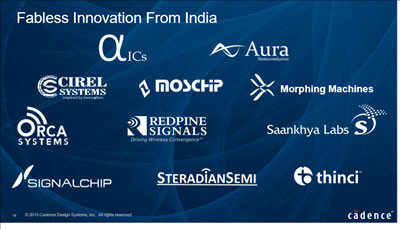 By Madhavi Rao, Marketing Director, Cadence Design Systems
By Madhavi Rao, Marketing Director, Cadence Design Systems
 There was a lot of excitement when the National Policy on Electronics was announced in 2012. However, in the six years that it has been in existence, it has not proven to be very effective in its aim of stemming the outflow of foreign exchange for electronics.
There was a lot of excitement when the National Policy on Electronics was announced in 2012. However, in the six years that it has been in existence, it has not proven to be very effective in its aim of stemming the outflow of foreign exchange for electronics.
Back in 2012 it was widely opined that India’s foreign exchange bill for electronics would exceed its bill for oil by 2020. India’s electronics import bill has doubled in five years to $57 billion. However, thanks to the depreciating Rupee, the oil import bill is expected to touch $125 billion in this financial year (ending in March 2019) – so maybe the two are still a ways away from being neck-and-neck. But that’s cold comfort. Statistics gleaned from several articles published in 2018 say that nearly 50% of the total amount of electronic products sold in India are imported. If you take the percentage of electronics components imported, it is even higher – up to 80%, according to online news reports. And India’s appetite for electronics products seems insatiable.
The Government has tried to curb the outflow of foreign currency for electronics by increasing import duties, but experts across the board agree that the real answer is improving competitiveness by increasing locally manufactured electronics and electronic components.
The National Policy on Electronics 2.0 – Will it deliver?
One of the ways that the Government is trying to course correct is by floating a revised draft National Policy on Electronics (NPE) 2.0 for public consultation – in other words, inviting suggestions from the public and industry at large. Interestingly, one of the key areas that NPE 2.0 talks about more than NPE 1.0 did is in fabless chip design. The NPE proposes the establishment of a venture fund for fabless chip design, a first-of-its-kind for chip design in the country.
This aspect of the NPE seeks to leverage on the country’s existing design strengths and the experience of dozens of Indian firms into outsourced chip design for some two decades or more. The establishment of a nodal agency to promote funding of fabless chip design gives it support, Government recognition and financial backing as well.
Cadence India Managing Director Jaswinder Ahuja gave a keynote speech at the VLSI Design Conference that was held in Delhi two weeks ago at which he spoke about the fact that there are many fabless chip design start-ups that have come up in the last 5-10 years. The image on the right mentions a few of them. So we have some good success stories in the fabless space. All of these are funded by private venture capital. Funding by the Government should encourage more entrepreneurs to venture into the fabless area.
Entrepreneurship is key
While the frameworks of both NPE 1.0 and 2.0 are both good, the challenge has been execution on the ground. In addition, entrepreneurship in this area seems to be sluggish, but that is exactly what is required to make a real impact.
In addition to the NPE, over the last few years there have been a few incubators and accelerators that have come up to encourage entrepreneurship. One of them is FabCi, launched by the Indian Institute of Technology Hyderabad, as an incubator to boost chip design in India. It aims to create an ecosystem to promote start-ups into chip design with free design software and a characterization facility. Cadence is a technology partner to FabCi.
Another is the Electropreneur Park (EP) in Delhi. EP is a first-of-its-kind electronic system design and manufacturing incubator fostered by the Ministry of Electronics and Information Technology and already has 16 start-ups in its fold. The EP provides not just infrastructure and access to funding but, crucially, mentorship as well.
The Indian Electronics and Semiconductor Association, the trade body that represents that electronics industry in India, recently launched the Semiconductor Fabless Accelerator Lab (SFAL) with the Government of Karnataka in December 2018 to incubate early-stage startups and existing SMEs in this segment. SFAL will provide access to funds, market and mentors for these young companies and plans to incubate at least 20 early stage fabless start-ups in the next three years and take it to 50 in the next five years.
It appears like India has all the ingredients to make some real impact in ESDM – funding, Government support, industry support, mentorship, and, most importantly, the end-market. Now we have to see whether there are enough individuals who have the passion, risk-taking ability and drive to take advantage of all this support and make a difference!
Blog link: https://community.cadence.com/cadence_blogs_8/b/india-circuit






